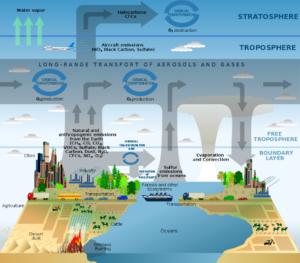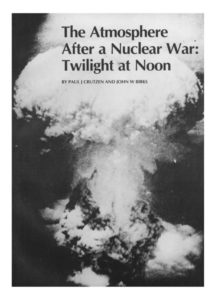
The genesis of the idea to explore the influence of certain papers on shaping the field of tropospheric chemistry came when editing a textbook chapter I had written a decade earlier. As I edited it I thought, what really is new; text-book worthy over the last 10 years? In some senses what is text-book worthy at all? These type of questions inspired me to think about where atmospheric chemistry has got to as a subject and to wonder if one were to ask “Which published papers have transformed our understanding of the chemical processes in the troposphere, and shaped the field of atmospheric chemistry?” (Monks et al., 2021), what would the answer be from the community and what insight would that give about where the subject is and could go.

Figure 1 – Schematic of chemical and transport processes related to atmospheric composition. These processes link the atmosphere with other components of the Earth system, including the oceans, land, and terrestrial and marine plants and animals (Mahoney et al., 2003).
It is clear that air quality and anthropogenic climate change are environmental issues of current and critical importance to society and its development. Atmospheric science often sits at an interesting, sometimes orthogonal intersection, between societal outcomes (e.g. acid precipitation, air quality and human health, ozone layer depletion, and climate) and its scientific venture. Underlying scientific venture and societal impact is atmospheric composition and the way it has changed from local to global scales (see Figure 1).
A small team was formed from A.R. Ravishankara (Colorado Sate Univ, USA), Erika Von Schneidemesser (IASS, Potsdam, Germany) and Roberto Sommariva (University of Leicester, UK) to explore how papers have shaped the development of the field of atmospheric chemistry, identify the major landmarks in the field of atmospheric chemistry through the lens of those papers’ impact on science, legislation and environmental events.
In the article, we also explore the ways in which one can identify the papers that have most impacted the field and discuss the advantages and disadvantages of the various approaches. There is no doubt a lot to choose from, with the simplest bibliometric searches suggesting that over 3,500 papers per annum are being produced. Easily measurable criteria, like the number of citations, are one metric of impact. However, this approach favours papers of a particular ‘vintage’ and not necessarily the earlier or later papers. Besides, there are several drawbacks to these simple and objective criteria. We decided to use a different approach that of soliciting the scientific community to obtain input from the experts in the field.
We had to have some ground rules; 2010 was selected as the cut-off year, the rationale being that for a paper to have been influential in the whole field it must be at least ten years old and thus had time to accrue recognition. In terms of expert solicitation, the solicitation was open, and a wide range of scientists and career stages contributed with a strong Europe/USA bias. Self-nominations were ignored (there where some!!) and we kept the scope broad on studies that have shaped our understanding of the atmosphere and the underlying chemical and physical processes, focusing mostly on the troposphere, including modelling, field measurements, remote sensing, and laboratory studies. Further, atmospheric interactions with the other elements of the Earth system such as biosphere, cryosphere and hydrosphere where embraced. The paper itself discusses some of the challenges in selecting the influential papers and in the end we decided not to produce a list, as this became too reductionist.

Figure 2 – Atmospheric sampling – UK FAAM research aircraft flying over the Borneo rainforest (Courtesy of Martin Irwin Photography/University of Manchester).
Clearly, we want the reader of this blog to go away and read and comment on the paper, but there are some interesting headlines. Over the history of atmospheric chemistry, ambient measurements are a cornerstone, as the atmosphere is under-sampled. Many ingenious ways have been devised to build different measurement strategies from the ground, airborne, balloon, sonde and space (see for example Figure 2). Within the measurement world, the role and impact in particular of long-term observations came to the fore. Breakthroughs in understanding observations have often emerged because of basic laboratory studies while the power of models as integrative tools to map, test and predict remains crucial. There have been developments in fields adjacent to atmospheric chemistry that have shaped progress in areas such as stratospheric chemistry, climate, health-impacts, ecosystems and ocean science.
It is also fair to say some interesting papers have come to light that reflect their times. For example, early applications of models to the global atmospheric and climatic consequences of nuclear war (Crutzen and Birks, 1982, see Figure 3) or some of the roots of aerosol science in measuring the number of live germs in the air (Aitken, 1888).
The work to date is published as a discussion paper in Atmospheric Chemistry and Physics (Monks et al., 2021), has I feel highlighted and captured the substantial scope of the atmospheric research endeavour over the last 60 years. We want very much to implore, invite and encourage the community, to weigh in on the choices and help determine the final shape of the work.
Edited by Mengze Li and Athanasios Nenes
References
Aitken, J.: On the Number of Dust Particles in the Atmosphere, Nature, 37, 428-430, 10.1038/037428a0, 1888.
Crutzen, P. J., and Birks, J. W.: The atmosphere after a nuclear war: twilight at noon, Amiibo, 11, 114-125, 1982.
Mahoney, J. R., Asrar, G., Leinen, M. S., Andrews, J., Glackin, M., Groat, C., Hohenstein, W., Lawson, L., Moore, M., Neale, P., Patrinos, A., Schafer, J., Slimak, M., and Watson, H.: Strategic Plan for the U.S. Climate Change Science Program, 2003.
Monks, P. S., Ravishankara, A. R., von Schneidemesser, E., and Sommariva, R.: Opinion: Papers that shaped Tropospheric Chemistry, Atmos. Chem. Phys. Discuss., 2021, 1-63, 10.5194/acp-2020-1266, 2021.

